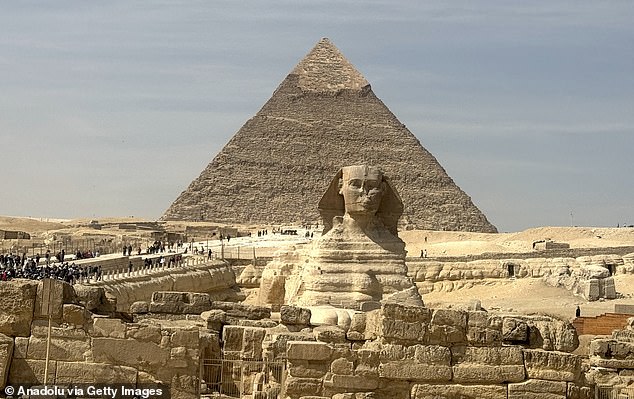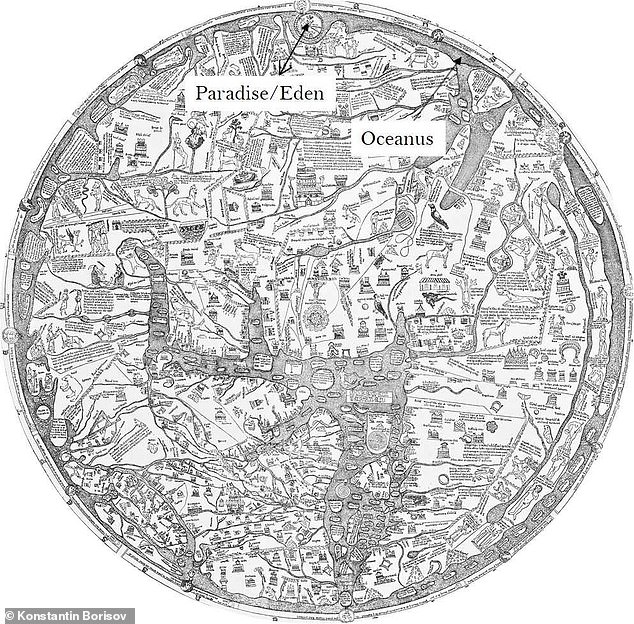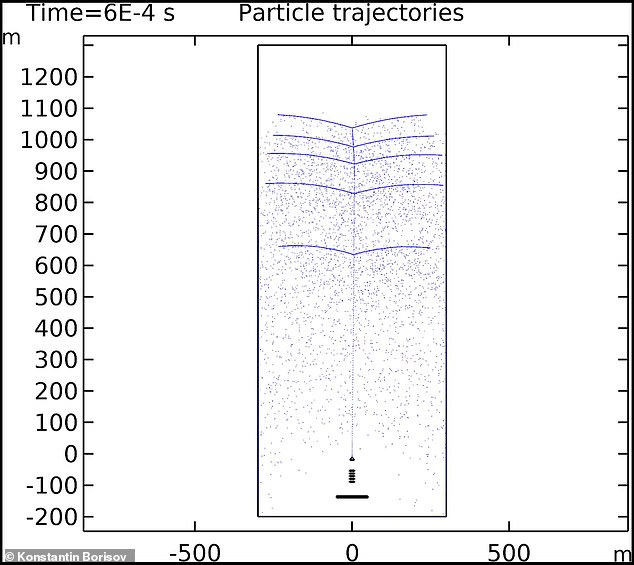A scientist has made a bold claim that the Garden of Eden was located in Egypt, rather than the traditionally accepted region of the Middle East.
According to the Bible, the Garden of Eden was a paradise where God placed Adam and Eve and featured a flowing river that split into four branches: Gihon, Euphrates, Tigris and Pishon.
Many scholars believe that because the Tigris and Euphrates are known in the region of Iraq, the nation must be where the Garden of Eden flourished.
However, Dr Konstantin Borisov, a computer engineer, has now argued that these rivers correspond to the Nile (Gihon), Euphrates, Tigris, and Indus (Pishon), which are in alignment with Medieval European world maps.
In his 2024 paper published in Archaeological Discovery, Borisov highlighted Medieval European maps that show a circular world surrounded by a river labeled ‘Oceanus’ and at the very top of the map is ‘Paradise,’ or Eden, sitting nearby.
‘By examining a map from around 500 BC, it becomes apparent that the only four rivers emerging from the encircling Oceanus are the Nile, Tigris, Euphrates and Indus,’ he wrote.
Even more, the researcher claim the Great Pyramid of Giza sits where the Tree of Life once grew, which the Bible states bears fruit that gives eternal life to whoever eats it.
Borisov said the study saw charge carriers gathered at the peak of the structure.
‘It cannot be overlooked, the charge particles in this simulation are arranged in a way that creates several parallel branches extending outward from the center line, creating a tree-like representation.’

Dr Konstantin Borisov, a computer engineer, has now argued that these rivers correspond to the Nile (Gihon), Euphrates, Tigris, and Indus (Pishon), which are all in alignment with Medieval European world maps. He also claimed the Great Pyramid was built where the Tree life sat
While there is no evidence of the Garden of Eden, many scholars believe it was in Iraq that is home to the Tigris and the Euphrates, which match descriptions in the Bible.
However, locations of the Gihon and the Pishon, if they still exist, are unknown.
This has led to a plethora of suggestions as to where the Garden of Eden might have been, ranging from Iran and Mongolia to Florida.
While the most promising theory is that the Garden of Eden was located in an area called Mesopotamia, Borisov believes he has found clues that it once flourished in Egypt.
Borisov drew from a wide range of sources, including ancient Greek texts, biblical scripture, medieval maps, and accounts from early historians, according to the study that was peer-reviewed.
He also incorporated mythological symbolism, geographic analysis and modern theories, such as Oceanus, to support his reinterpretation of the Garden of Eden’s possible location.
In ancient times, there was a belief regarding the existence of Oceanus that encircled the entire world.
The Book of Genesis 2:8-17 states that a river flowed out of Eden toward the east to water the garden, and from there it divided and became four branches.’

According to the Bible, the Garden of Eden was a paradise where God placed Adam and Eve, featuring a river that split into four branches: Gihon, Euphrates, Tigris and Pishon
The passage explains that the first branch was Pishon;’it is the one that flows around the whole land of Havilah.
‘The name of the second river is Gihon; it is the one that flows around the whole land of Cush. The name of the third river is Tigris, which flows east of Assyria. The fourth river is the Euphrates. The Lord God took the man and put him in the Garden of Eden to toll it and keep it.’
While there is no place on Earth where one river splits into all four, a late 1290s European world map features such a location.
Borisov highlighted the Hereford Mappa Mundi shows a circular world surrounded by a river labeled ‘Oceanus.’
At the very top of the map is ‘Paradise,’ or Eden, shown sitting directly next to this river.
The researcher also noted that Titus Flavius Josephus, a Romano-Jewish scholar and historian, wrote in Antiquities Book 1, Chapter 1, Section 3: ‘Now the garden was watered by one river, which ran round about the whole earth, and was parted into four parts.
‘And Phison, which denotes a multitude, running into India, makes its exit into the sea, and is by the Greeks called Ganges. Euphrates also, as well as Tigris, goes down into the Red Sea.
‘Now the name Euphrates, or Phrath, denotes either a dispersion, or a flower: by Tigris, or Diglath, is signified what is swift, with narrowness; and Geon runs through Egypt, and denotes what arises from the east, which the Greeks call Nile.’
‘Geon’ is the ancient Greek word for ‘Gihon.’

Borisov highlighted the Hereford Mappa Mundi that shows a circular world surrounded by a river labeled ‘Oceanus.’ At the very top of the map is ‘Paradise,’ or Eden, shown sitting directly next to this river

Borisov said the study saw charge carriers gathered at the peak of the structure. ‘It cannot be overlooked, the charge particles in this simulation are arranged in a way that creates several parallel branches extending outward from the center line, creating a tree-like representation
Borisov wrote that because the historian wrote that only ‘the Eden River irrigates the Garden, and not any of the other four rivers mentioned in the Bible (Antiquity 1.1.3), and thus, we can assert that the Garden of Eden lies around the globe along the course of Oceanus.’
‘At this point, all the rivers of the Bible are identified, and it seems that all we need is to follow the course of the Oceanus River around the globe to pinpoint the location of Eden.’
However, he also noted that to be sure, he would need to determine ‘the precise course of Oceanus.’
But this adds to his claims that the Great Pyramid of Giza sits where the Tree of Life once stood, which the Bible states bears fruit that gives eternal life.
The Bible says that anyone who eats the fruit from the tree will have eternal life.
The Great Pyramid of Giza stands 455 feet tall and spans about 756 feet in width.
In 2012, researchers created computer simulations for the inside of the Great Pyramid King’s chamber, finding the charged particles gathered at the peak of the structure.
‘While emitted from the pyramid, the charge particles collide with neutral nitrogen and oxygen atoms, leading to their ionization, resulting in the release of photons, predominantly in shades of purple and green,’ Borisov shared.
‘In the simulation, each branch corresponds to a layer of beams in the relieving chamber, with five layers in total. Consequently, the simulated tree has five distinct branches.’






